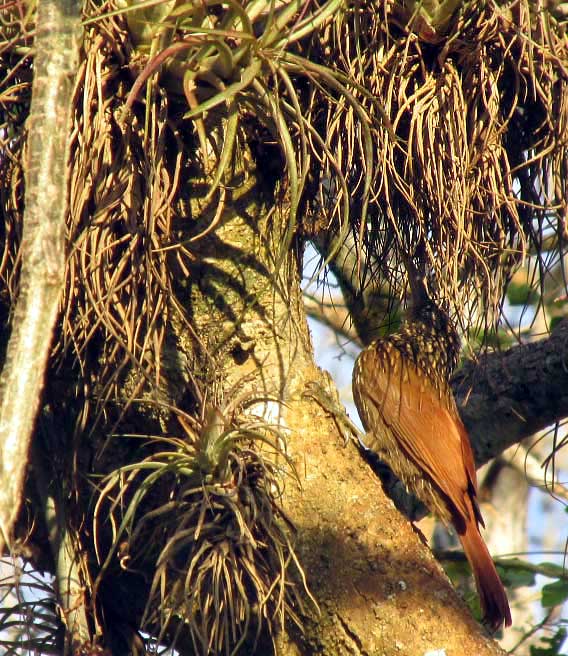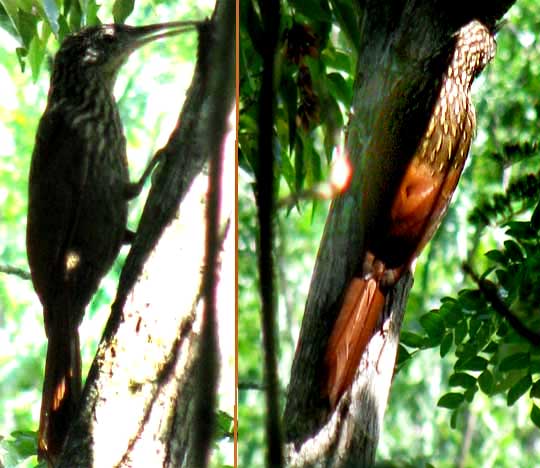Excerpts from Jim Conrad's
Naturalist Newsletter
from the March 13, 2016 Newsletter issued from Hacienda Chichen Resort beside Chichén Itzá Ruins, central Yucatán MÉXICO
IVORY-BILLED WOODCREEPER POKING AT BROMELIADS

"Creeper," I've written, not "pecker." Ivory-billed Woodcreepers are fairly common in these parts and this week I got a new picture of one doing exactly what Ivory-billed Woodcreepers are doing during the mid dry season, shown above.
What they're doing is obsessively jabbing their big beaks into dense, wiry clumps of bromeliads, sometimes jerking out the bromeliads' older, dried-up leaves and letting them fall to the ground. I'm guessing that the procedure exposes tiny creatures sheltering there, and that's the woodcreeper's food.
Northerners shouldn't assume that our tropical woodcreepers are as small and retiring as the North's Brown Creepers, who share the species' form, behavior and color. Our woodcreepers are woodpecker-size birds, and they can emit sharp, robust cheeeoh' calls when they want.
When volunteer identifier Bea of Ontario was here, she got a nice Ivory-billed Woodcreeper picture, too. When I congratulated her, she said there'd been nothing to it because the bird had been right above her throwing bromeliad leaves at her, making him hard to overlook.
from the November 24, 2008 Newsletter issued from Yokdzonot, Yucatán, México
IVORY-BILLED WOODCREEPER
Woodcreepers are tropical American birds, and 13 species are listed for Mexico. You can see the big-billed, heavily spotted, generally rusty-red species frequenting the cenote's shadowed tree-trunks, the Ivory-billed Woodcreeper, below:

Though woodcreepers aren't closely related to anything up north, they forage on tree trunks and limbs like woodpeckers, and in shape, form and behavior are very much like the North's Brown Creeper. Brown Creepers are little birds, however, only 4-¾ inch long (12 cm). Our Ivory-billed Woodcreeper, XIPHORHYNCHUS FLAVIGASTER, averages around 9-½ inches (24 cm).
Sometimes woodcreepers are hard to identify because the species are so similar. In this part of the Yucatan it's not so bad because only three species occur and they're fairly distinct from one another. However, in lowland Chiapas around the ruins of Palenque I've spent many hours trying to separate that area's eleven potentially found species. Woodcreepers tend to hectically flit from shadowy spot to shadowy spot and you end up anguishing over how spotty the spotty backs and breasts you glimpsed where and what the spots' shapes were, how pale the pale bills were, how reddish the reddish backs and breasts, etc.
I hear this bird more than see it. As it glides from tree to tree it issues occasional sharp, explosive calls. It seems to keep a pretty tight schedule, too, arriving at about the same time each morning, rushing through the cenote area, then leaving.
Ivory-billed Woodcreepers are distributed from Mexico to Costa Rica. They're considered common in forests, forest edges, plantations and mangroves.